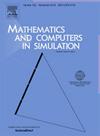Three-dimensional D3Q27 multiple-relaxation-time lattice Boltzmann simulation of Herschel–Bulkley viscoelastic fluids in a cubic cavity with top lid driven diagonally
IF 4.4
2区 数学
Q1 COMPUTER SCIENCE, INTERDISCIPLINARY APPLICATIONS
引用次数: 0
Abstract
Graphics Processing Unit (GPU) accelerated multiple-relaxation-time (MRT) lattice Boltzmann method (LBM) is used for the simulation of Herschel–Bulkley non-Newtonian fluids in a three-dimensional (3D) cubic cavity with the top lid-driven diagonally. For the 3D simulation, a D3Q27 lattices model, which is more stable and well-accepted in the LBM community, is used in the present MRT-LBM. Simulations using numerical models are run for a variety of dimensionless variables, including the Reynolds numbers (), Bingham number (), Power-law index, (). In the present numerical simulation, the GPU has used a parallel computing technique based on the Compute Unified Device Architecture (CUDA) C++ programming. MRT-LBM code is validated for the Newtonian and non-Newtonian power law fluid with a lid-driven cubic cavity. The numerical results obtained regarding the streamlines, velocity, viscosity distributions, and the iso-surfaces of the non-Newtonian viscosity are presented. The current numerical findings could potentially function as benchmark results for validating 3D codes validation for the non-Newtonian fluids.
三维D3Q27多重弛豫时间晶格Boltzmann模拟顶盖对角驱动的立方腔中Herschel-Bulkley粘弹性流体
采用图形处理单元(GPU)加速多重松弛时间(MRT)晶格玻尔兹曼方法(LBM)模拟了顶盖对角线驱动的三维(3D)立方腔中的Herschel-Bulkley非牛顿流体。在三维仿真方面,MRT-LBM采用了D3Q27晶格模型,该模型较为稳定,在LBM界被广泛接受。使用数值模型对各种无因次变量进行了模拟,包括雷诺数(Re=300,600,1000,1200), Bingham数(Bn=0.0,0.5,1.0,2.0),幂律指数(n=0.8)。在目前的数值模拟中,GPU采用了基于CUDA c++编程的并行计算技术。MRT-LBM代码验证了牛顿和非牛顿幂律流体与盖子驱动的立方腔。给出了非牛顿黏度的流线、速度、黏度分布和等面等方面的数值结果。目前的数值结果可能作为验证非牛顿流体3D代码验证的基准结果。
本文章由计算机程序翻译,如有差异,请以英文原文为准。
求助全文
约1分钟内获得全文
求助全文
来源期刊

Mathematics and Computers in Simulation
数学-计算机:跨学科应用
CiteScore
8.90
自引率
4.30%
发文量
335
审稿时长
54 days
期刊介绍:
The aim of the journal is to provide an international forum for the dissemination of up-to-date information in the fields of the mathematics and computers, in particular (but not exclusively) as they apply to the dynamics of systems, their simulation and scientific computation in general. Published material ranges from short, concise research papers to more general tutorial articles.
Mathematics and Computers in Simulation, published monthly, is the official organ of IMACS, the International Association for Mathematics and Computers in Simulation (Formerly AICA). This Association, founded in 1955 and legally incorporated in 1956 is a member of FIACC (the Five International Associations Coordinating Committee), together with IFIP, IFAV, IFORS and IMEKO.
Topics covered by the journal include mathematical tools in:
•The foundations of systems modelling
•Numerical analysis and the development of algorithms for simulation
They also include considerations about computer hardware for simulation and about special software and compilers.
The journal also publishes articles concerned with specific applications of modelling and simulation in science and engineering, with relevant applied mathematics, the general philosophy of systems simulation, and their impact on disciplinary and interdisciplinary research.
The journal includes a Book Review section -- and a "News on IMACS" section that contains a Calendar of future Conferences/Events and other information about the Association.
 求助内容:
求助内容: 应助结果提醒方式:
应助结果提醒方式:


